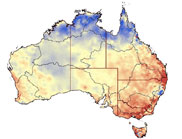Aug 26 2009
New analysis shows that the water scarcity being experienced in southeast Australia started up to 15 years ago.
 The long-term trend in total water availability in soil and groundwater between 1980 and 2008 (red areas have experienced declines over this period, blue areas increases). The dry state of the catchments show that a return of rainfall does not automatically mean streamflows will return to previous rates.
The long-term trend in total water availability in soil and groundwater between 1980 and 2008 (red areas have experienced declines over this period, blue areas increases). The dry state of the catchments show that a return of rainfall does not automatically mean streamflows will return to previous rates.
While the results from the work by senior CSIRO researcher, Dr Albert van Dijk, may not surprise many people, it provides scientific evidence of the shift.
The finding follows the first ever national and comprehensive analysis of 30 years of on-ground and satellite observations of Australia’s water resources.
Dr Albert van Dijk told the the Sixth International Scientific Conference on the Global Energy and Water Cycle in Melbourne today that the analysis provides a valuable, new insight into the country’s water balance.
”The data shows the first signs of diminishing water availability in Australia appeared somewhere between 1993 and 1996 when the rate of water resource capture and use started to exceed the rate of streamflow supply,” Dr van Dijk said.
Dr van Dijk’s work is part of the water information research and development alliance between the CSIRO’s Water for a Healthy Country Flagship and Bureau of Meteorology in which scientists are building an observation and modelling system that will provide water balance estimates across Australia.
Long-term on-ground records and 30 years of satellite observations are combined with models that integrate and analyse the data within a powerful computer system that provides comprehensive, detailed and reliable information about the nation’s water resources.
”If this technology had been available to us in the mid-1990s, the onset of dry conditions could have been detected earlier,” Dr van Dijk said.
“The results of the study underscore the importance of good water information for water resource planning.”
The data also reveals that the impact of the drought on Australia’s current water resources is broadly consistent with both the historical trend and climate change predictions.
“Parts of Australia have had record low rainfall the last several years, but our records aren’t very long and the drought may still be within natural limits.”
“What makes the situation appear so much worse is that the sixties and seventies were quite wet. That’s also when we started capturing river flows in large reservoirs for our growing cities and irrigated agriculture. In retrospect it appears we have become over-reliant on what is now looking like ‘bonus’ rainfall during that time.”
The observation system that is developed will assist the Bureau in conducting regular water resource assessments and produce national water accounts.